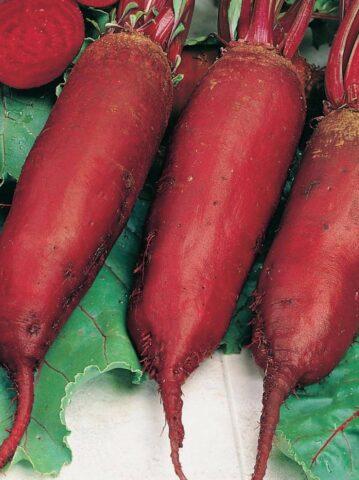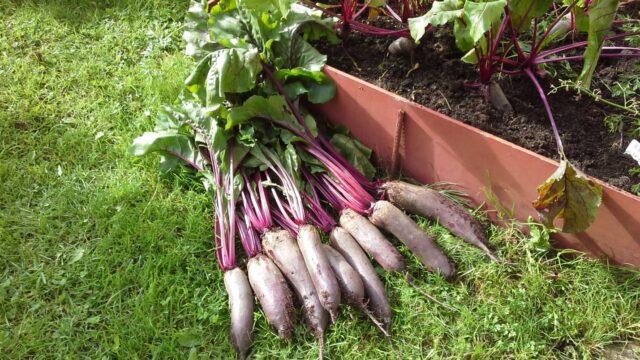Content
Cylinder beet is a Russian large-fruited variety with good taste and high yield (up to 10 kg per square meter). Differs in a cylindrical shape of root crops, thanks to which they are conveniently stored and stored. The variety is unpretentious, available for cultivation in most Russian regions.
Origin story
Cylindra beet is a large-fruited variety bred on the basis of the Marinda agricultural firm (Moscow). The culture has passed tests and is included in the register of breeding achievements in 1998. It is approved for cultivation in most Russian regions:
- middle band;
- Northwest;
- Volga region;
- Black earth;
- southern territories;
- Ural;
- Western and Eastern Siberia;
- Far East.
Beet variety description Cylinder
Cylinder beet leaves are medium in size, light green in color. The edges are slightly wavy, the surface is glossy, the veins of pink-violet are noticeable. Leaf rosettes are erect and semi-erect.
Root crops of a characteristic cylindrical shape, for which the variety got its name. They reach 4–7 cm in diameter, 15 cm in length, strongly elongated. The tip is small, pointed, the head is medium in size, the shape is flat, slightly rising above the ground.
The beet pulp of the Cylinder variety is dark red, tender in consistency, characterized by juiciness and pleasant aroma. There are no light rings, but sometimes there is indistinct ringing. Root crops are very large, the mass reaches from 250 to 600 g. The surface is smooth, leveled, burgundy.

The taste is pleasant in beets. Cylinder is sweetish, characterized as good and excellent.
Root crops are transportable - they can be transported long distances to the point of sale or processing. Shelf life is good - up to 6-7 months, subject to standard storage conditions (temperature 2-5 degrees Celsius, humidity level up to 70%, dark place).
The purpose of beet root crops The cylinder is universal. They can be used fresh for preparing vitamin salads, as well as in all kinds of dishes. Beets are also suitable for harvesting for the winter.
Characteristics of Beet Cylinder
The Cylinder variety is valued for its very high yield of 8-10 kg from 1 m2 (with industrial cultivation from 700 to 1000 centners per hectare). The variety is mid-season: technical ripeness occurs on average 100–120 days after germination. Ripening rates strongly depend on the region - in the south it takes 80–90 days, in cool summer conditions - 130 days. The crop can be harvested four months after germination, i.e. from late July to early September (depending on the landing date).
Variety Cylinder is sensitive to cold weather - flower stalks can form due to a decrease in night temperature. Therefore, planting in the open ground is planned only in May, when the threat of return frosts will no longer exist. Beets are resistant to drought, which makes it possible to grow them even in regions with insufficient rainfall.
Advantages and disadvantages
Cylinder beet has undoubted advantages.Many summer residents and farmers are attracted by its simplicity, high yield and excellent taste. Although the variety is not as resistant to frost as others, so planting should be planned at a time when the soil warms up well.

Cylinder beets are characterized by increased productivity
Pros:
- excellent taste;
- attractive presentation;
- large root crops;
- high commodity yield;
- good keeping quality and transportability;
- drought resistance;
- the pulp does not change color during cooking;
- can be grown in all regions of the country.
Minuses:
- The cylinder is sensitive to frost - it can give flower stalks;
- the variety is picky about lighting, does not tolerate the slightest shadow;
- on acidic and clayey soils, it gives an insignificant yield.
Planting Beet Cylinder
Cylinder beets are quite demanding on the composition of the soil. The soil should be light, fertile (loam or sandy loam with a slightly acidic or neutral pH from 6.0 to 7.0 is suitable). The place should be dry (not low) and completely open - then the yield will be high, and the taste will be pleasant.
The timing of planting beets of the Cylinder depends on the cultivation method and the climate characteristics of a particular region:
- Seeds for seedlings are planted a month before transplanting into the ground, i.e. in early April (in the south - at the end of March).
- Seedlings are planted in the garden in mid-May. In the south, this is done at the beginning of the month, and in regions with cool springs - in the last decade.
- If grown by planting seeds in the ground, then the procedure is planned for the middle or second half of May.
- It is allowed to plant Cylinder beets before winter (also in open ground). In this case, sowing is planned for the second half of September - early October.
Growing seedlings
Growing by seedlings allows you to accelerate the ripening of root crops by 1–1.5 months and get a harvest at the end of July. The seeds must be prepared in advance:
- put in salt water and discard those that float;
- soak, hold the glass in the refrigerator for a week;
- pickle in potassium permanganate or fungicide (if not done by the manufacturer).
Cylinder beets are one-germ varieties. This means that only one plant grows from a seed. You can grow seedlings in common containers. The soil is purchased in a store or made up from garden soil mixed with humus, black peat and sand (2: 1: 1: 1).

It is convenient to grow beet seedlings in cassettes
Seeds are planted to a depth of 1–2 cm, covered with foil and placed in a warm place (room temperature). When shoots appear, the film is removed, the temperature is lowered to 15 degrees, and 2 weeks before transplanting, they begin to harden at 10-12 ° C. Periodically moisten the soil from the sprayer.
The seedlings are transferred to the open ground after the formation of four true leaves. You can not hesitate, since the seedlings will be pulled out. On the other hand, planting too early is dangerous due to frost.
Landing in open ground
From mid to late May, Cylinder beet seeds can be planted outdoors. Prepare them in the same way as in the case of seedlings. The landing pattern is as follows:
- depth - 2-3 cm;
- the interval between seeds is 10 cm;
- the interval between rows is 30 cm.
After planting, give some water. At the first stages, the seedlings need moisture, therefore, watering is intensified, then it is rare, as needed.
Cylinder beet care in the open field
Caring for Cylinder beets is not very difficult. The basic rule is regular watering, especially during drought (although plants develop normally in hot weather). The culture is responsive to feeding - fertilizers provide maximum yield. They need to be entered several times per season:
- On the eve of planting, add urea in the amount of 15-20 g per 1 m2.
- In the initial stages of the formation of root crops, you can water with any organic matter.
- Three weeks after that, feed with superphosphate (40 g per 1 m2) and potassium salt (20 g per 1 m2).
In order for the beets to grow quickly, you should avoid caking the soil, especially if it is dense. After 1-2 days after heavy rains and watering, it is recommended to loosen the surface layer. Weeding is carried out as needed, preventing the active growth of weeds.

The beets are harvested on a sunny day without rain
Possible diseases and pests
Cylinder beets have good immunity to most diseases and pests. But due to bad weather and improper care (frost, excess moisture, dense planting, heavy, acidic soil) can suffer from such pathologies:
- brown rot (gray bloom on the root crop);
- "Black leg" (darkening of the roots);
- downy mildew (grayish-lilac bloom on the leaves);
- phomosis (brownish spots on the inside of the leaf plate).
For prevention, you must follow the rules of agricultural technology. When signs of disease appear, all affected plants are destroyed, and then they are treated with a fungicide (Bordeaux liquid, "HOM", "Skor", "Maxim", "Profit" or another agent).
Conclusion
Cylinder beet is an unpretentious crop that tolerates drought normally and is resistant to many diseases and pests. The agrotechnology of its cultivation is simple, so even a novice summer resident will get a good harvest.
Reviews of gardeners about the beets of the Cylinder








